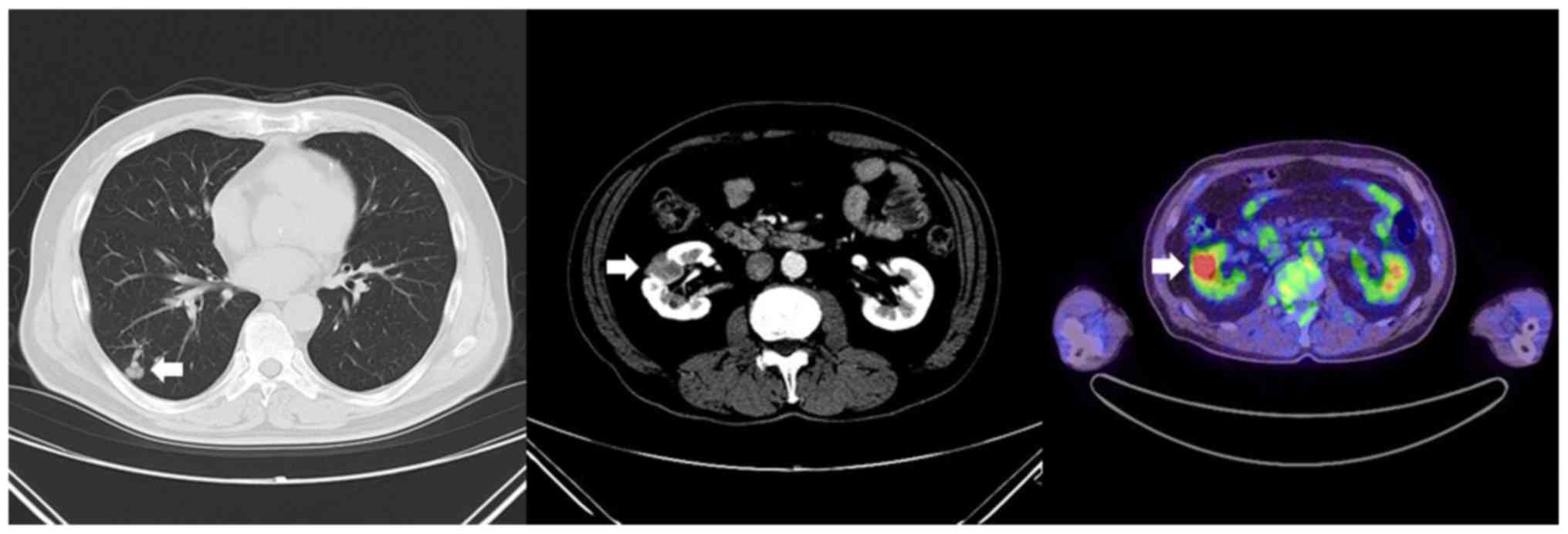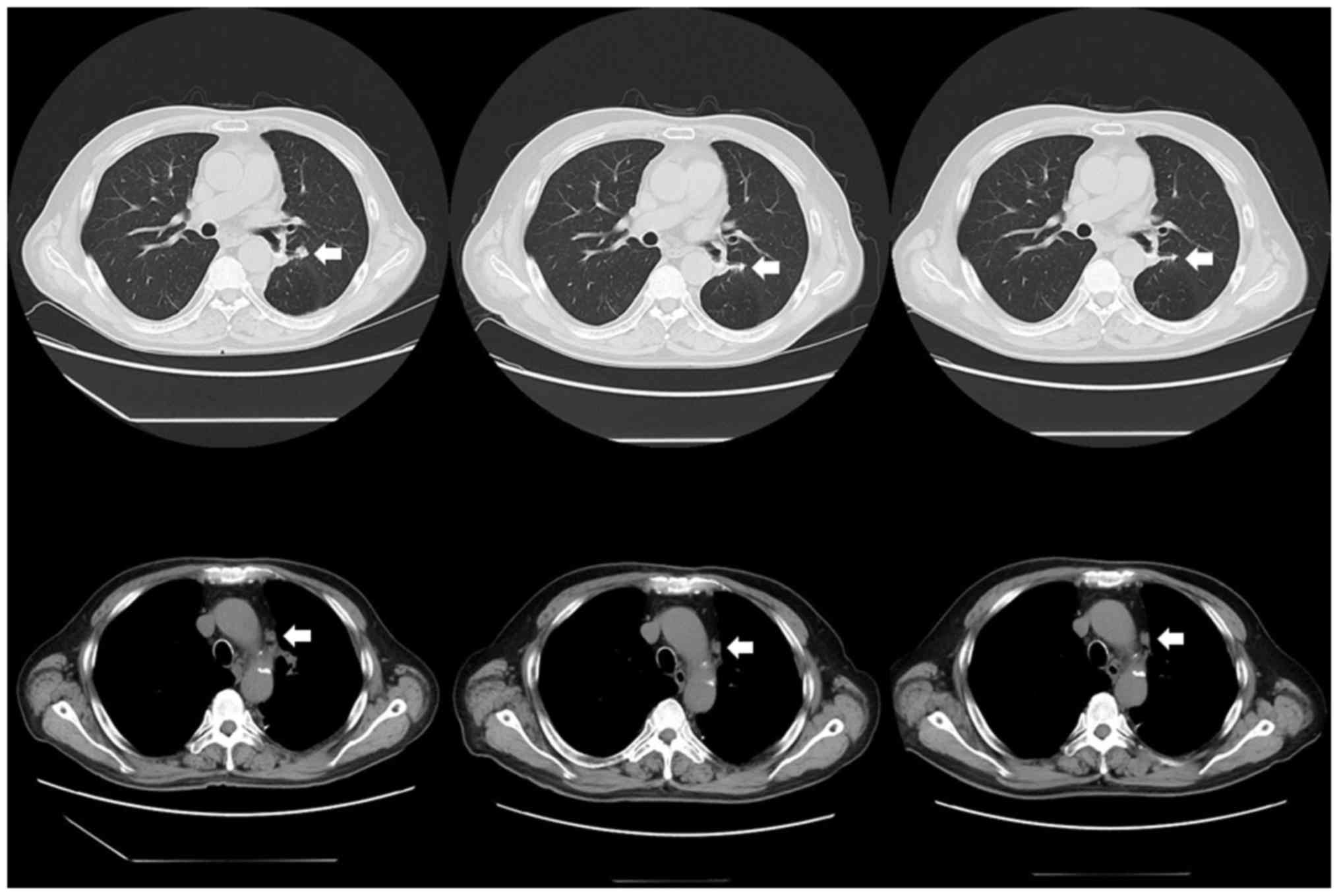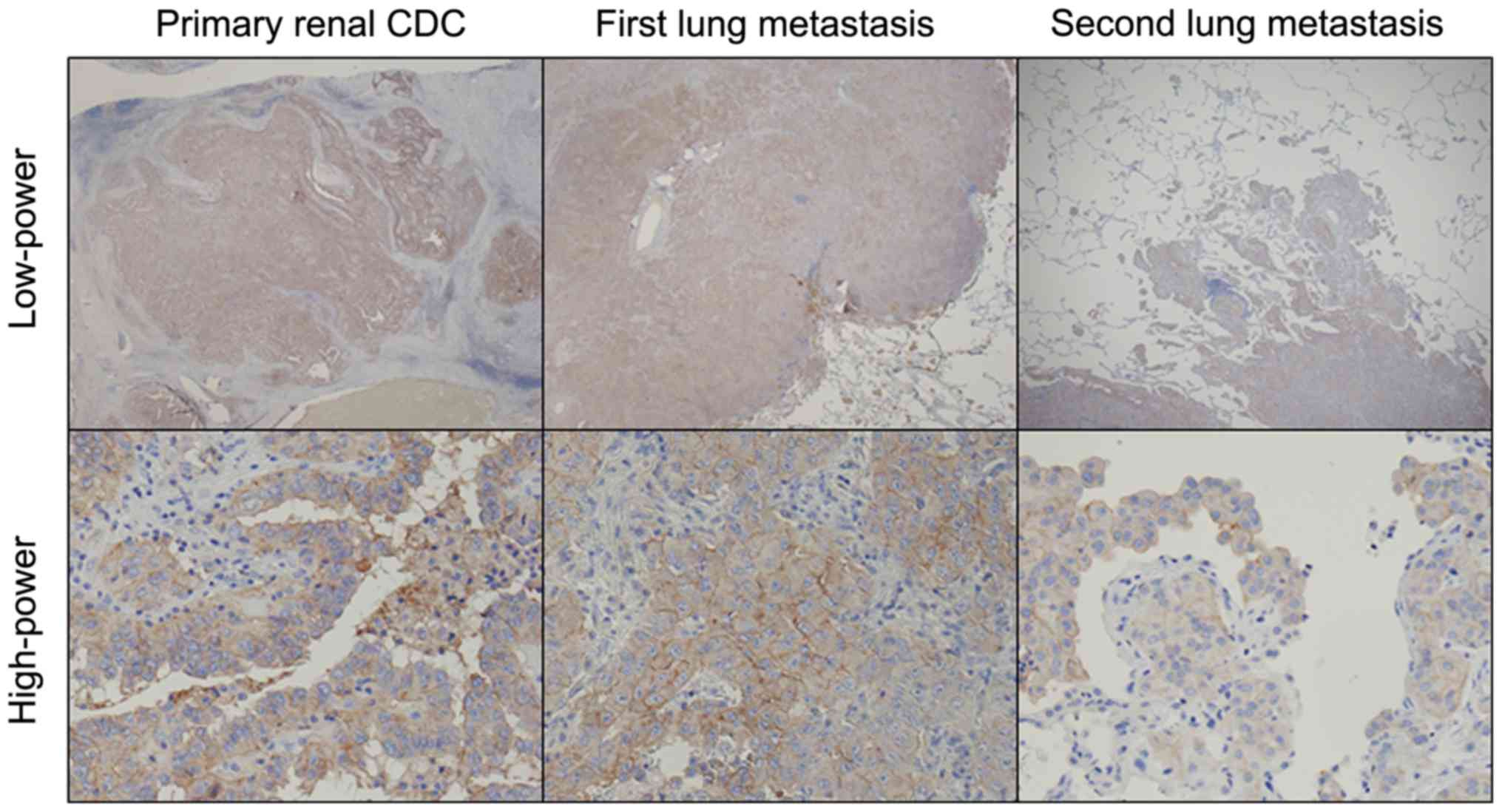Response to nivolumab in metastatic collecting duct carcinoma expressing PD‑L1: A case report
- Authors:
- Published online on: October 12, 2017 https://doi.org/10.3892/mco.2017.1449
- Pages: 988-990
-
Copyright: © Mizutani et al. This is an open access article distributed under the terms of Creative Commons Attribution License.
Abstract
Introduction
Collecting duct carcinoma (CDC) is a rare variant subtype of renal cell carcinoma (RCC) known to originate in the distal collecting duct and to have an extremely poor prognosis, which is reported to be due to limited success with chemotherapy and targeted therapy (1,2).
Programmed death 1 (PD-1) is a receptor expressed on activated T cells and binds to its ligands PD-L1 and PD-L2, which are present on antigen-presenting cells and tumor cells. PD-1 inhibitor blocks the interaction of PD-1 and its ligands and eventually restores antitumor immunity. Nivolumab improves overall survival in several cancers including RCC (3,4). It was reported that the expression of PD-L1 correlates with the effect of nivolumab in metastatic melanoma and some types of lung cancer, but the correlation is unclear in clear cell RCC (3–5). Although nivolumab improved overall survival of patients with antiangiogenic treatment-relapsed RCC with a clear-cell component compared with everolimus, the usefulness of nivolumab for CDC is unclear.
In the present study, we report a case showing a favorable response to nivolumab in metastatic CDC. We also show the expression of PD-L1 in surgical specimens.
Case report
A 64-year-old man with a past history of papillary adenocarcinoma of thyroid cancer presented with bilateral lung tumors that were detected incidentally on positron emission tomography/computed tomography (PET/CT) for systemic evaluation of post-treatment thyroid cancer. PET/CT also revealed a right renal mass. A dynamic contrast-enhanced CT scan suggested that the renal tumor mass may be a metastatic renal tumor or non-clear RCC (Fig. 1). The patient underwent a core biopsy of the renal mass, and histological examination of the specimen was interpreted as carcinoma of renal origin. The patient had also undergone laparoscopic right radical nephrectomy and video-assisted thoracoscopic segmentectomy of the right lung at the same time. The left lung tumor was not resected because it was too small to conclude that it was metastasis, and it was followed with careful watching. Pathology diagnosed the renal tumor and resected lung tumor to be CDC and metastasis of CDC, respectively. Subsequently, four courses of chemotherapy with a combination of gemcitabine and cisplatin or carboplatin were administered as adjuvant therapy (Fig. 2).
Fifteen months after the first surgery, a follow-up CT scan showed that the left lung mass had increased in size. Video-assisted thoracoscopic segmentectomy of the left lung was performed, and this tumor was also diagnosed as metastasis of CDC. Pathology also revealed a small metastasis in the specimen of left lung; therefore, second-line chemotherapy with a combination of gemcitabine and paclitaxel was administered to the patient. A follow-up CT scan showed incidences of mediastinal lymph node and lung metastasis. The patient was treated with temsirolimus, and the metastasis remained at the same size for 30 months. However, a follow-up CT scan indicated increased size of the lung and lymph node metastases. The patient was then deemed a candidate for immune checkpoint inhibitor therapy with nivolumab. Six months after the treatment with nivolumab, a CT scan showed complete response of the lung metastasis and stable disease of the lymph node metastasis (Fig. 3). The therapy with nivolumab is ongoing with no adverse events.
To the best of our knowledge, there are no reported studies of immune checkpoint inhibitor therapy and PD-L1 expression in CDC. We elucidated the expression of PD-L1 by immunohistochemistry using anti-PD-L1 (clone 28-8) antibody. As shown in Fig. 4, PD-L1 was highly expressed in all the surgical specimens (primary renal collecting duct carcinoma, first lung metastasis and second lung metastasis).
Written informed consent was obtained from the patient. The study was approved by the Ethics Committee of Gifu University, Graduate School of Medicine (approval no. 29-303).
Discussion
Rimar et al reported that nivolumab induced a clinical response to metastatic CDC without evaluating PD-1 or PD-L1 expression (6). To the best of our knowledge, the present report is the first to show that nivolumab induces a clinical response in metastatic CDC with evaluation of PD-L1 expression in surgical specimens.
Although it is not clear whether PD-L1 expression in surgical specimens is a predictive biomarker, some researchers have interpreted a high level of PD-L1 expression as possibly correlating with the effect of anti-PD-1/PD-L1 antibodies in several types of cancer (7). In a study on advanced RCC treated with nivolumab or everolimus, the median overall survival was 21.8 months in patients with >1% PD-L1 expression and 27.4 months in patients with <1% PD-L1 expression in the nivolumab group (4). Although the expression level of PD-L1 and its role in cancer prognosis remain to be elucidated, previous findings have shown that PD-L1 expression may vary in cancer types, and a high expression of PD-L1 is associated with poor clinical outcomes including that from clear cell RCC (8–10). On the basis of the mechanism of immune checkpoint inhibitor therapy, nivolumab to contribute to the improvement of clinical outcome in cancer that is exacerbated by the increased expression of PD-L1. The findings in the present case indicate to us that a high expression of PD-L1 in lung metastasis of CDC to contribute to a favorable clinical response to nivolumab. Further studies may demonstrate the effect of nivolumab on CDC and the correlation of PD-L1 expression with its benefit for CDC are anticipated.
Glossary
Abbreviations
Abbreviations:
|
CDC |
collecting duct carcinoma |
|
PET/CT |
positron emission tomography/computed tomography |
|
PD-1 |
programmed death 1 |
|
RCC |
renal cell carcinoma |
References
|
Chao D, Zisman A, Pantuck AJ, Gitlitz BJ, Freedland SJ, Said JW, Figlin RA and Belldegrun AS: Collecting duct renal cell carcinoma: Clinical study of a rare tumor. J Urol. 167:71–74. 2002. View Article : Google Scholar : PubMed/NCBI | |
|
Yin M, Wang W, Rosenberg J, Kaag M, Joshi M, Holder S, Tuanquin L and Drabick JJ: Targeted therapy in collecting duct carcinoma of the kidney: A case report and literature review. Clin Genitourin Cancer. 14:e203–e206. 2016. View Article : Google Scholar : PubMed/NCBI | |
|
Borghaei H, Paz-Ares L, Horn L, Spigel DR, Steins M, Ready NE, Chow LQ, Vokes EE, Felip E, Holgado E, et al: Nivolumab versus docetaxel in advanced nonsquamous non-small-cell lung cancer. N Engl J Med. 373:1627–1639. 2015. View Article : Google Scholar : PubMed/NCBI | |
|
Motzer RJ, Escudier B, McDermott DF, George S, Hammers HJ, Srinivas S, Tykodi SS, Sosman JA, Procopio G, Plimack ER, et al: Nivolumab versus Everolimus in advanced renal-cell carcinoma. N Engl J Med. 373:1803–1813. 2015. View Article : Google Scholar : PubMed/NCBI | |
|
Robert C, Long GV, Brady B, Dutriaux C, Maio M, Mortier L, Hassel JC, Rutkowski P, McNeil C, Kalinka-Warzocha E, et al: Nivolumab in previously untreated melanoma without BRAF mutation. N Engl J Med. 372:320–330. 2015. View Article : Google Scholar : PubMed/NCBI | |
|
Rimar KJ, Meeks JJ and Kuzel TM: Anti-programmed death receptor 1 blockade induces clinical response in a patient with metastatic collecting duct carcinoma. Clin Genitourin Cancer. 14:e431–e434. 2016. View Article : Google Scholar : PubMed/NCBI | |
|
Zhang T, Xie J, Arai S, Wang L, Shi X, Shi N, Ma F, Chen S, Huang L, Yang L, et al: The efficacy and safety of anti-PD-1/PD-L1 antibodies for treatment of advanced or refractory cancers: A meta-analysis. Oncotarget. 7:73068–73079. 2016.PubMed/NCBI | |
|
Erlmeier F, Weichert W, Schrader AJ, Autenrieth M, Hartmann A, Steffens S and Ivanyi P: Prognostic impact of PD-1 and its ligands in renal cell carcinoma. Med Oncol. 34:992017. View Article : Google Scholar : PubMed/NCBI | |
|
Wang X, Teng F, Kong L and Yu J: PD-L1 expression in human cancers and its association with clinical outcomes. Onco Targets Ther. 9:5023–5039. 2016. View Article : Google Scholar : PubMed/NCBI | |
|
Xu F, Xu L, Wang Q, An G, Feng G and Liu F: Clinicopathological and prognostic value of programmed death ligand-1 (PD-L1) in renal cell carcinoma: A meta-analysis. Int J Clin Exp Med. 8:14595–14603. 2015.PubMed/NCBI |













